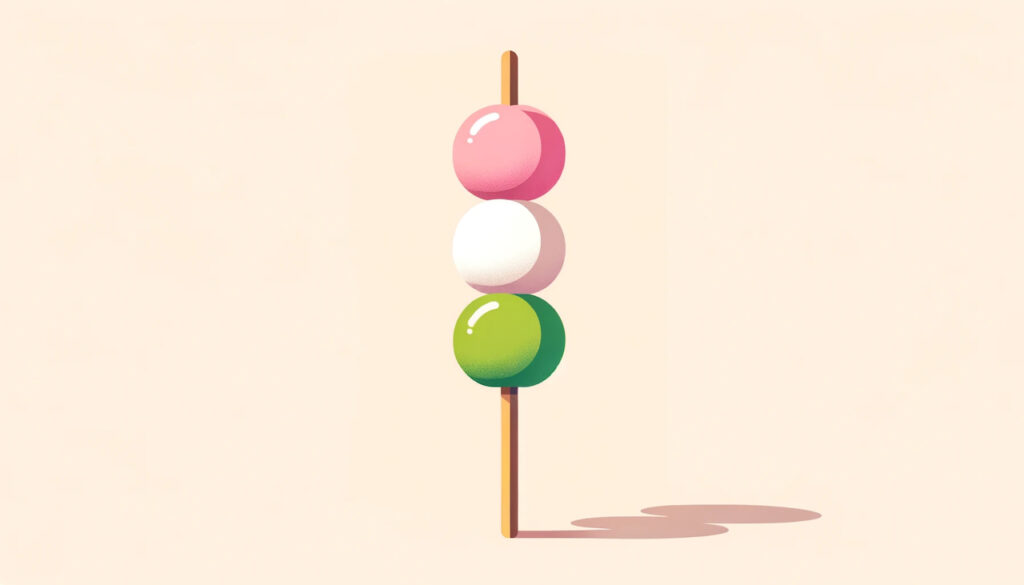If you’ve ever visited Japan during cherry blossom season, you may have come across a charming skewer of pastel-colored dumplings called sanshoku dango. These three-colored rice sweets—pink, white, and green—are not just visually delightful, but deeply symbolic as well. In this article, we’ll uncover the cultural meanings behind each color, the traditional order of the dango on the skewer, and the fascinating history that has shaped this seasonal Japanese treat.
What Is Sanshoku Dango?
Sanshoku dango (literally “three-colored dango”) is a traditional Japanese sweet made of soft, chewy rice flour dumplings.
Skewered in a trio of colors—pink, white, and green—this sweet is especially popular in spring, particularly during hanami (cherry blossom viewing) festivities.
The Meaning Behind the Colors
Each color in sanshoku dango represents more than just aesthetics—it tells a story rooted in nature, spirituality, and seasonal transition:
🌸 Pink – Spring and New Beginnings
Pink symbolizes cherry blossoms, Japan’s iconic sign of spring. It stands for:
- The start of new life and warmer days
- Joy, love, and emotional renewal
- Protection against misfortune
⚪ White – Purity and Reflection
White reflects snow and the final breath of winter. It’s a color associated with:
- Clean slates and spiritual purity
- The transition from winter into spring
- Honoring ancestors and embracing inner peace
🍃 Green – Growth and Rebirth
Green represents nature’s renewal as life awakens. It signifies:
- Health and vitality
- Long life and prosperity
- Harmony with nature, a core value in Japanese culture
The Traditional Order of Colors
On a skewer, sanshoku dango is usually arranged top to bottom as:
Pink → White → Green
This order carries its own set of meanings:
- Seasonal Change: Pink for spring, white for lingering winter, green for the coming of summer
- Life’s Cycle: Birth, maturity, and renewal
- Cherry Blossom Progression: From buds (pink), to full bloom (white), to fresh new leaves (green)
This sequence adds layers of meaning to what may seem like a simple snack.
A Brief History of Sanshoku Dango
Sanshoku dango dates back to the Heian period (794–1185), when colorful food was used in imperial court ceremonies to celebrate the seasons.
Pink dango were particularly favored during spring rituals, especially those related to cherry blossom viewing.
In the Edo period (1603–1868), sanshoku dango became popular among everyday people. Vendors sold the colorful treats in parks and temples during hanami season.
The symbolic meanings of each color became more pronounced, and sanshoku dango solidified its place as a seasonal staple in Japanese culture.
Sanshoku Dango in Modern Japan
Today, sanshoku dango remains a beloved wagashi (traditional Japanese sweet) enjoyed during spring festivals and hanami picnics.
Its vibrant colors are often featured in seasonal packaging, special events, and even modern creations—like the sanshoku dango-inspired Frappuccino released by Starbucks Japan.
This sweet continues to bridge Japan’s past and present, embodying the nation’s reverence for nature, balance, and the passing of time.
Conclusion
Sanshoku dango is more than just a festive treat—it’s a symbol of seasonal change, cultural tradition, and the beauty of nature in harmony.
Each bite carries centuries of meaning, reminding us to savor not just the flavor, but the spirit of spring itself.
So the next time you enjoy sanshoku dango under blooming cherry trees, you’ll know you’re tasting a story written in color, tradition, and timeless celebration.


